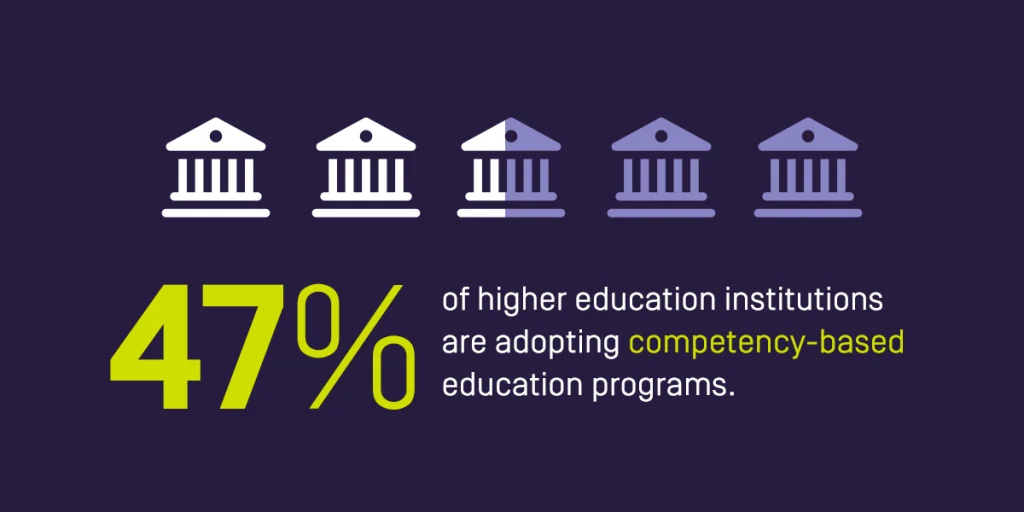
Between rapid technological advancements, economic tribulations, and shifting societal factors, the higher education system in America is constantly transforming to keep up with changing times.
Exploring the latest trends in higher education can help institutions like yours stay on the cutting edge and deliver the most impactful academic experiences possible for your students.
9 higher education trends in 2024
The higher education sector looks different than it did just five years ago. With so much change and evolution comes exciting advancements for your institution to keep on its radar. Explore the following higher ed trends making waves in the academic world:
1. Online education
Online learning remains a fast-growing area of higher education. In 2024, the United States is projected to reach $87.51 billion in revenue in the online education market — the highest among the countries included in Statista’s research.
Today’s undergraduate students want flexibility, and online coursework helps them manage busy schedules while still working toward a degree. To deal with this shift, higher education institutions must take steps to make themselves as digitally accessible as possible, such as optimizing their websites to be more mobile-friendly and provide an enhanced user experience overall.
What’s more, increased online learning means students are not as restricted to attending a higher education institution in their specific location. Higher education institutions can reach more students by increasing their online presence and making courses and faculty more easily searchable.
2. Artificial intelligence
The rise of artificial intelligence (AI) is changing and enhancing many academic processes for students, educators, and higher education institutions.
AI tools can assist with admissions, automating administrative tasks, and personalizing applicant experiences. They are highly beneficial for tasks like:
- Coordinating schedules.
- Setting budgets.
- Recordkeeping.
These advanced solutions can also help your facility streamline workloads with AI-powered teaching assistants, grading systems, and educational content.
Students can utilize AI solutions to help them comprehend complex topics, fine-tune assignments, and prepare for assessments. Higher education institutions must acknowledge the powers of artificial intelligence and consider implementing guidelines for students and administrators.
3. Shifting student demographics
The changing higher education landscape has also led to shifting student demographics. Notably, the rise of online courses has attracted more nontraditional students who need the flexibility to balance their education with working and caring for their families. With online courses, higher education institutions can expand their student body and equip a wider group of individuals for success.
In addition to nontraditional students, younger learners make up a significant portion of student populations on college campuses. The NCES projects that the number of students under age 25 will increase by 5 percent between 2018 and 2029. This demographic diversity requires a strategic approach to meet the needs of every student, whether they’re attending classes online or in person. For example, higher education institutions must navigate generational differences in technology use.
To successfully prepare students for the workforce, higher education institutions must understand their student demographics. What kind of students are interested in their campus and online programs? What needs do these students have outside of completing coursework?
4. Increase in capital campaigns
Education administrators are focusing on capital campaigns targeted at private donors to raise money. The COVID-19 pandemic and subsequent economic troubles over the past few years have taken a toll on higher education funding. These campaigns are helping make up for the losses and fund academic programs through generous alumni and other donors.
Beyond this, higher education institutions are increasingly seeking employees with the skills to launch capital campaigns and other fundraising efforts.
Large-scale capital campaigns are gaining popularity among higher education institutions thanks to their effectiveness and positive influence on ongoing fundraising efforts.
5. Data-driven decision-making
Higher education institutions are increasingly relying on data analytics for their strategic decision-making. Analytics allow education leaders to gain valuable insights from student and faculty feedback that goes beyond basic reporting. They can then use these insights to make more informed decisions and successfully navigate the evolving higher education landscape.
Using data for predictive analytics can play a huge role in your institution’s student retention and enrollment efforts. Your faculty can use these insights to recognize at-risk students and pair them with the resources needed for success. They are also useful in enhancing the enrollment process and helping administrators boost conversion rates.
Data also empowers higher education institutions to create a solid financial plan for their future. Predicting student enrollment is an important part of understanding cash flow in higher ed. With more data, administrators and leaders can navigate finances with wisdom and preparedness.
6. Competency-based education

Higher education institutions are also redefining student success. Many colleges and universities are moving away from relying on traditional exams to measure student progress and are instead focusing on student career readiness through competency-based learning. This approach can be especially beneficial to improving completion rates for nontraditional learners.
Approximately 47 percent of higher education institutions surveyed by the American Institutes for Research reported being in the process of adopting competency-based education programs. Experts expect that number to increase through 2025.
These programs shift the focus away from technical degrees. With employers increasingly looking for candidates with soft skills, many students seek out competency-based education programs to give themselves a competitive edge. Taking a career-readiness approach in your institution’s programs can boost student success and increase enrollment.
7. Learning management systems
As higher education institutions incorporate more technology into their courses, they also need to harness tools to keep their operations running smoothly.
A learning management system (LMS) is a software program for administering, documenting, tracking, automating, and reporting on your institution’s educational programs. This tool makes it easier to develop and distribute course content, track student progress, and report on course quality and student outcomes for accreditation.
For higher education institutions that develop extensive online programs, access to an LMS is extremely valuable. These systems help instructors communicate with students, keep track of assignments, update grades, and more. Since the demand for online learning is increasing, the need for learning management systems is, too.
8. MicroMasters programs
MicroMasters programs are an extension of online learning and competency-based education. They are graduate-level courses offered at top higher education institutions and available exclusively online. These programs are generally equivalent to shorter master’s degree programs geared to specific studies and career areas. They may be self-paced or instructor-led, depending on the institution.
MicroMasters programs are career-focused and recognized by many top companies. Several colleges and universities already have MicroMasters programs in place, including the following:
- Boston University
- Massachusetts Institute of Technology (MIT)
- Georgia Tech
- The University of Pennsylvania
Implementing a MicroMasters program can attract an educated, working demographic to your higher education institution. Many MicroMasters programs can be rolled over into a full master’s program if adult students want to take their educational journey even further.
9. Popular degree programs
As the job market changes, so do popular degree programs. According to digital lending marketplace Credible, which looked at majors that could be expected to lead to jobs in growing fields that would allow earners to make more than $60,000 annually, the “best” majors for postsecondary students in 2024 include:
- Biology.
- Business.
- Computer and information technology.
- Engineering.
- Healthcare.
Today’s students are looking to earn a degree in a field that interests them, suits their skills, and offers adequate job opportunities for life after graduation. In fact, a report from Deloitte shows that many modern higher education students are evaluating higher education by its return on investment — or whether they’re able to find a high-paying job after completing their degree.
As the economy changes, it only makes sense that higher education should, too. Transparency about cost and an accurate understanding of the job market can equip higher education institutions to better meet the needs of their students and help launch them successfully into employment after graduation. Your institution should regularly evaluate the programs you offer and how accessible they are to students.
The impact of trends on higher ed administrators
In many industries, trends come and go. However, educational trends reflect changes in the larger culture. Trends give key insights into the changing needs of students, empowering higher education institutions to offer the highest value.
Over the next few years, higher education will continue to change. Higher education institutions can prepare for these changes by staying on top of the latest research and adapting their programs to meet changing needs. These nine recent trends in higher ed can give you a head start.
Before you can adapt to trends, you need the structure to sustain administrative changes. Planning protects employees and administrators from being overwhelmed when things change. Adopting new processes always requires an adjustment period, and you can minimize this process with the right administrative assistance systems.
Schedule a demo to see how Watermark software can enhance your institution

At Watermark, our software solutions give institutions the tools and insights they need to monitor current and future trends in education. Our tools simplify data collecting and reporting, helping you identify important shifts and make more informed decisions to drive student success.
We’ll help your institution save time and money on repetitive administrative tasks and reporting. We make it easy to stay ahead of the competition and adjust quickly to changing higher education trends.
Ready to take your higher education institution to the next level? Request a software demo from Watermark today.















































































































































































































































































































































































































